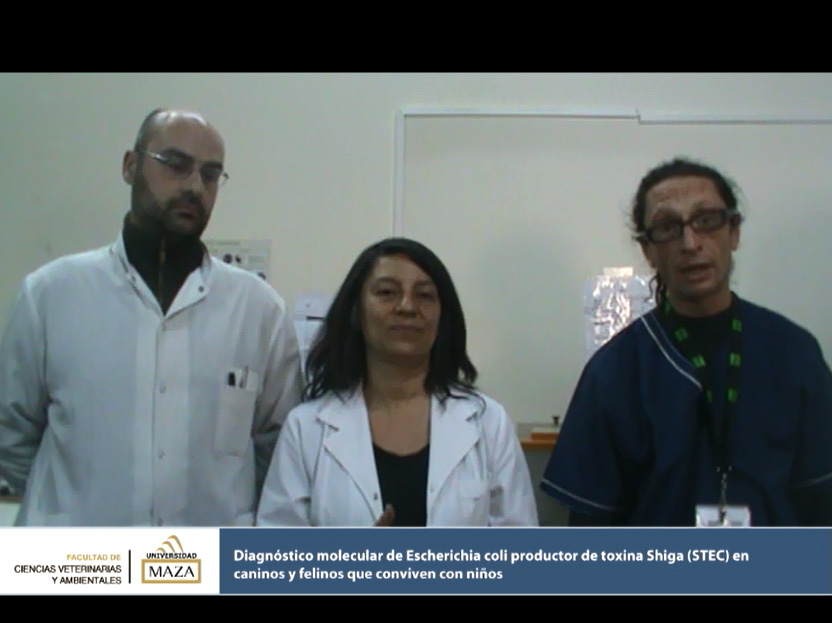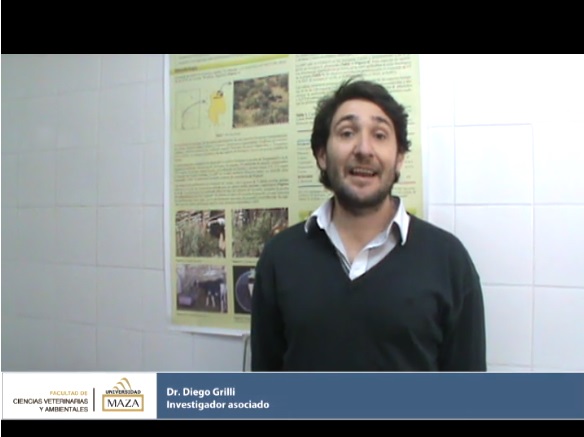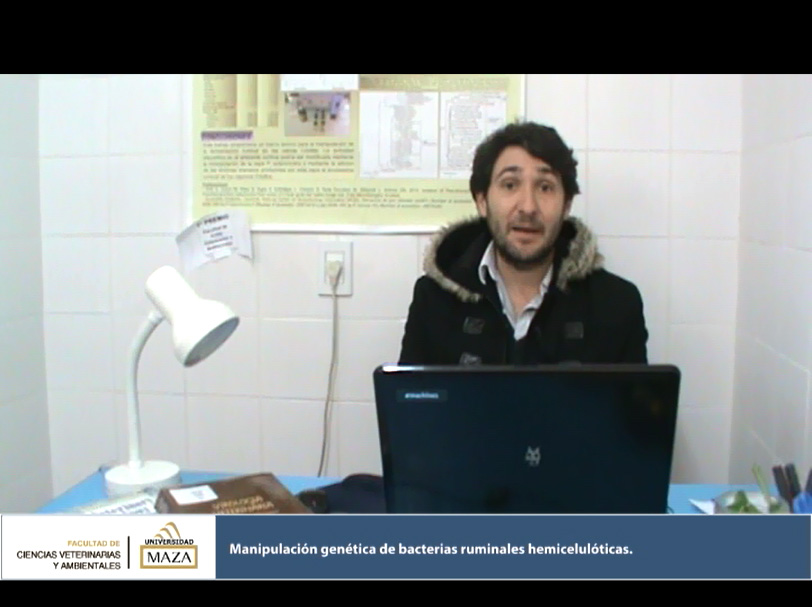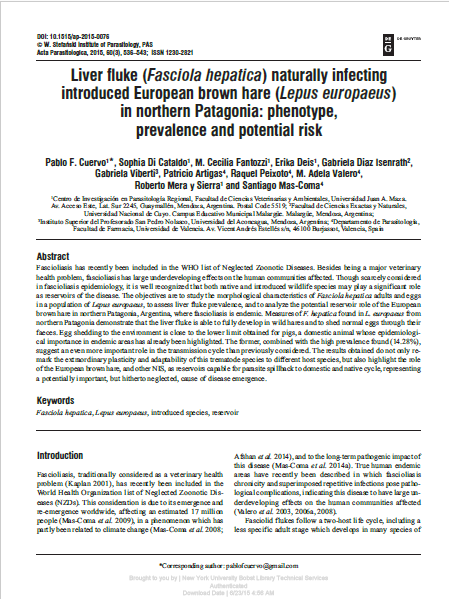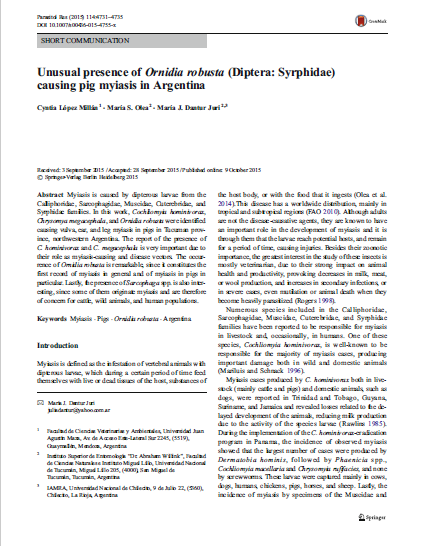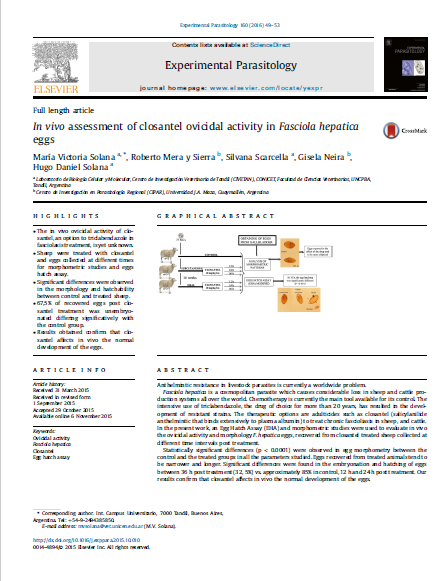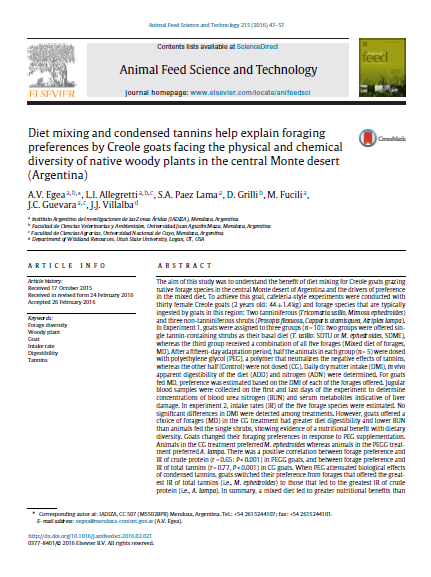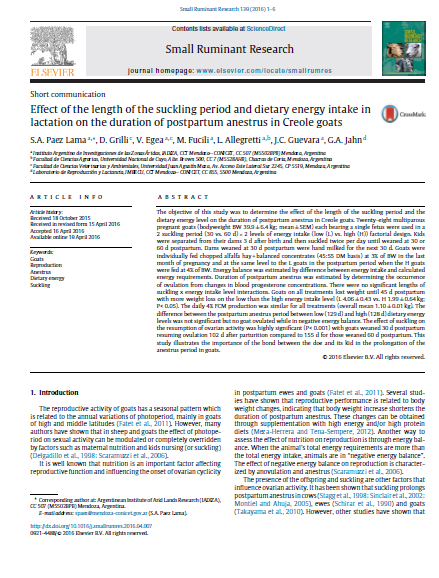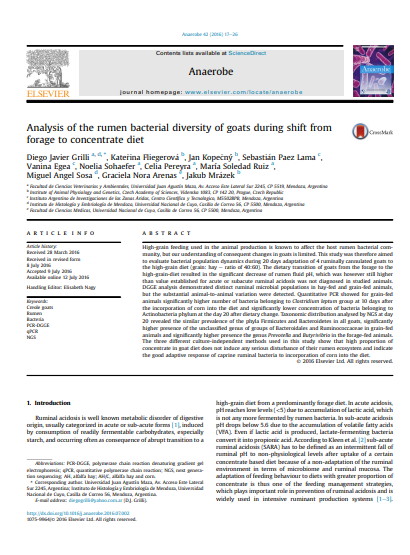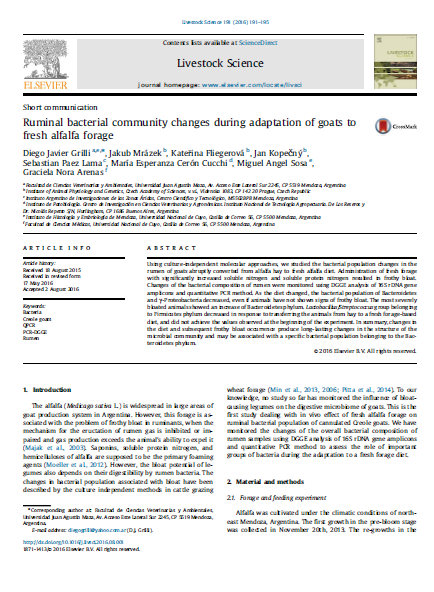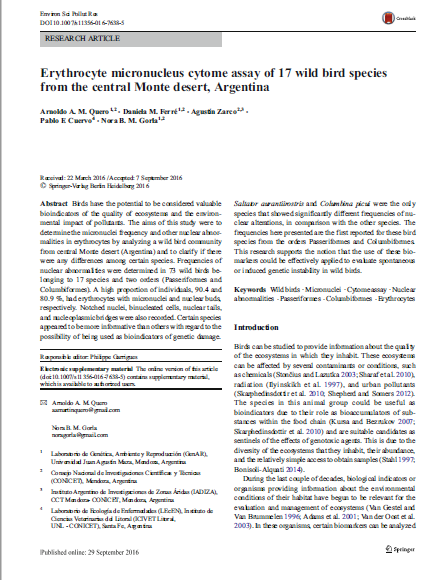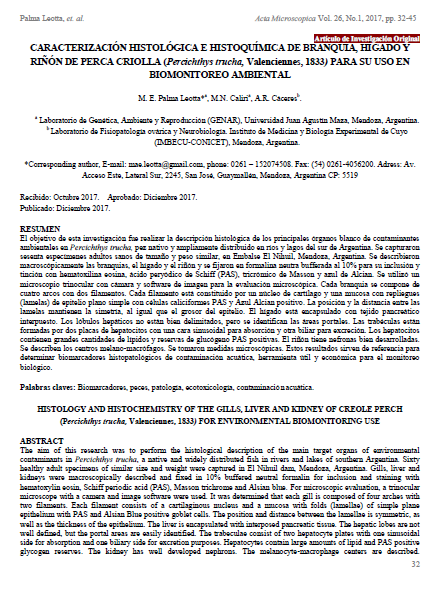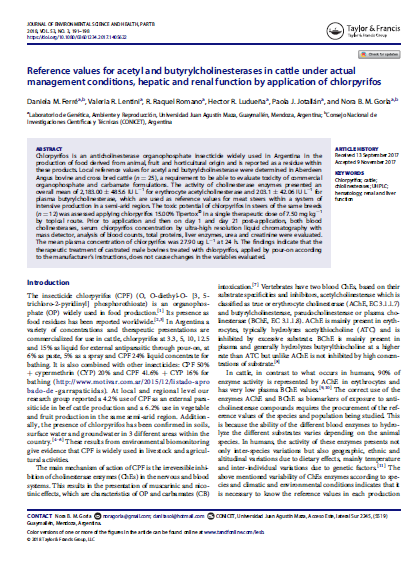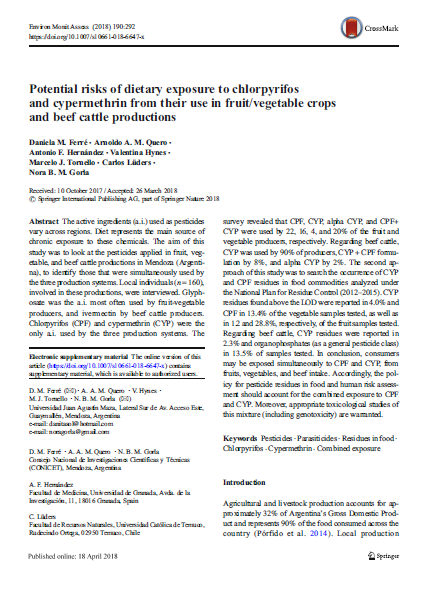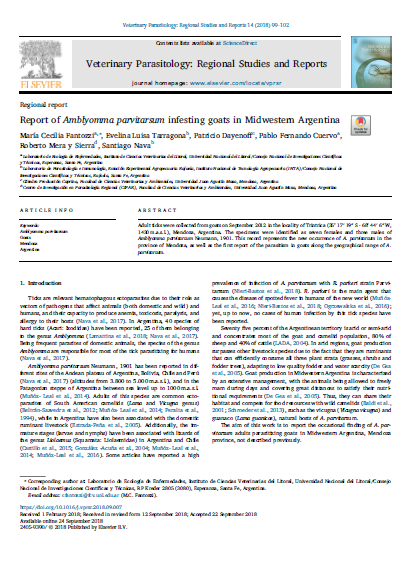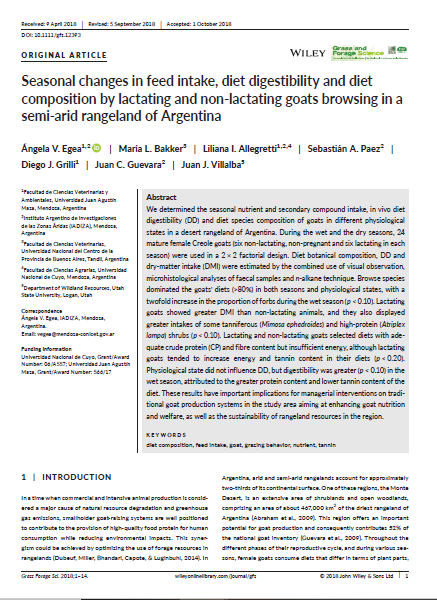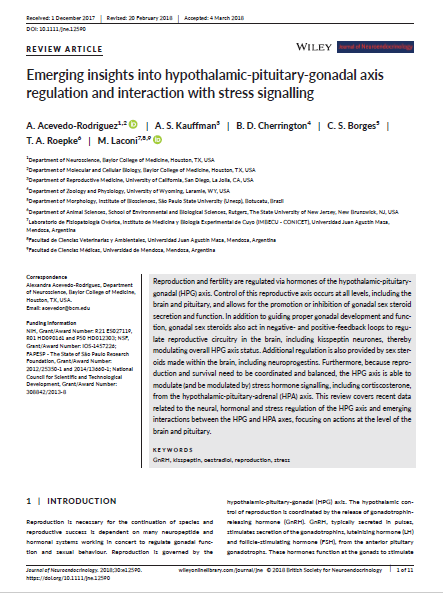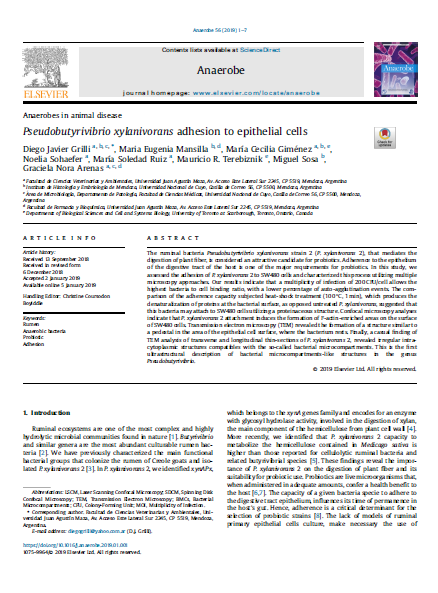Browsing Ciencias veterinarias by Issue Date
Now showing items 1-20 of 25
-
Liver fluke (Fasciola hepatica) naturally infecting introduced European brown hare (Lepus europaeus) in northern Patagonia: phenotype, prevalence and potential risk
(Comité editorial Acta Parasitologica, 2015-06-23)Fascioliasis has recently been included in the WHO list of Neglected Zoonotic Diseases. Besides being a major veterinary health problem, fascioliasis has large underdeveloping effects on the human communities affected. Though scarcely considered in fascioliasis epidemiology, it is well recognized that both native and introduced wildlife species may play a significant role as reservoirs of the disease. The objectives are to study the morphological characteristics of Fasciola hepatica adults and eggs in a population of Lepus europaeus, to assess liver fluke prevalence, and to analyze the potential ... -
Unusual presence of Ornidia robusta (Diptera: Syrphidae) causing pig myiasis in Argentina.
(Comité editorial Parasitology Research, 2015-10-09)Myiasis is caused by dipterous larvae from the Calliphoridae, Sarcophagidae, Muscidae, Cuterebridae, and Syrphidae families. In this work, Cochliomyia hominivorax, Chrysomya megacephala, and Ornidia robusta were identified causing vulva, ear, and leg myiasis in pigs in Tucuman province, northwestern Argentina. The report of the presence of C. hominivorax and C. megacephala is very important due to their role as myiasis-causing and disease vectors. The occurrence of Ornidia robusta is remarkable, since it constitutes the first record of myiasis in general and of myiasis in pigs in particular. ... -
In vivo assessment of closantel ovicidal activity in Fasciola hepatica eggs.
(Editorial Experimental Parasitology, 2016)Anthelmintic resistance in livestock parasites is currently a worldwide problem. Fasciola hepatica is a cosmopolitan parasite which causes considerable loss in sheep and cattle production systems all over the world. Chemotherapy is currently the main tool available for its control. The intensive use of triclabendazole, the drug of choice for more than 20 years, has resulted in the development of resistant strains. The therapeutic options are adulticides such as closantel (salicylanilide anthelmintic that binds extensively to plasma albumin) to treat chronic fascioliasis in sheep, and cattle. In ... -
Diet mixing and condensed tannins help explain foraging preferences by Creole goats facing the physical and chemical diversity of native woody plants in the central Monte desert (Argentina).
(Comité editorial Animal Feed Science and Technology, 2016-02-26)The aim of this study was to understand the benefit of diet mixing for Creole goats grazingnative forage species in the central Monte desert of Argentina and the drivers of preferencein the mixed diet. To achieve this goal, cafeteria-style experiments were conducted withthirty female Creole goats (2 years old; 44 ± 1.4 kg) and forage species that are typicallyingested by goats in this region: Two tanniniferous (Tricomaria usillo, Mimosa ephedroides)and three non-tanniniferous shrubs (Prosopis flexuosa, Capparis atamisquea, Atriplex lampa).In Experiment 1, goats were assigned to three groups (n ... -
Effect of the length of the suckling period and dietary energy intake in lactation on the duration of postpartum anestrus in Creole goats.
(Comité editorial Small Ruminant Research, 2016-04-16)The objective of this study was to determine the effect of the length of the suckling period and the dietary energy level on the duration of postpartum anestrus in Creole goats. Twenty-eight multiparous pregnant goats (bodyweight BW 39.9 ± 6.4 kg; mean ± SEM) each bearing a single fetus were used in a 2 suckling period (30 vs. 60 d) × 2 levels of energy intake (low (L) vs. high (H)) factorial design. Kids were separated from their dams 3 d after birth and then suckled twice per day until weaned at 30 or 60 d postpartum. Dams weaned at 30 d postpartum were hand milked for the next 30 d. Goats ... -
Analysis of the rumen bacterial diversity of goats during shift from forage to concentrate diet.
(Comité editor Journal Anaerobe, 2016-07-12)High-grain feeding used in the animal production is known to affect the host rumen bacterial community, but our understanding of consequent changes in goats is limited. This study was therefore aimed to evaluate bacterial population dynamics during 20 days adaptation of 4 ruminally cannulated goats to the high-grain diet (grain: hay e ratio of 40:60). The dietary transition of goats from the forage to the high-grain-diet resulted in the significant decrease of rumen fluid pH, which was however still higher than value established for acute or subacute ruminal acidosis was not diagnosed in studied ... -
Ruminal bacterial community changes during adaptation of goats to fresh alfalfa forage.
(Editorial Livestock Science, 2016-08-02)Using culture-independent molecular approaches, we studied the bacterial population changes in the rumen of goats abruptly converted from alfalfa hay to fresh alfalfa diet. Administration of fresh forage with significantly increased soluble nitrogen and soluble protein nitrogen resulted in frothy bloat. Changes of the bacterial composition of rumen were monitored using DGGE analysis of 16S rDNA gene amplicons and quantitative PCR method. As the diet changed, the bacterial population of Bacteroidetes and γ-Proteobacteria decreased, even if animals have not shown signs of frothy bloat. The most ... -
Erythrocyte micronucleus cytome assay of 17 wild bird species from the central Monte desert, Argentina.
(Editorial Environmental Science and Pollution Research, 2016-09-29)Birds have the potential to be considered valuable bioindicators of the quality of ecosystems and the environmental impact of pollutants. The aims of this study were to determine the micronuclei frequency and other nuclear abnormalities in erythrocytes by analyzing a wild bird community from central Monte desert (Argentina) and to clarify if there were any differences among certain species. Frequencies of nuclear abnormalities were determined in 73 wild birds belonging to 17 species and two orders (Passeriformes and Columbiformes). A high proportion of individuals, 90.4 and 80.9 %, had erythrocytes ... -
Caracterización histológica e histoquímica de branquia, hígado y riñón de perca criolla ( Percichthys trucha, Valenciennes, 1833 ) para su uso en biomonitoreo ambiental
(Comité editorial Acta microscópica, 2017-12)El objetivo de esta investigación fue realizar la descripción histológica de los principales órganos blanco de contaminantes ambientales en Percichthys trucha, pez nativo y ampliamente distribuido en ríos y lagos del sur de Argentina. Se capturaron sesenta especímenes adultos sanos de tamaño y peso similar, en Embalse El Nihuil, Mendoza, Argentina. Se describieron macroscópicamente las branquias, el hígado y el riñón y se fijaron en formalina neutra bufferada al 10% para su inclusión y tinción con hematoxilina eosina, ácido peryódico de Schiff (PAS), tricrómico de Masson y azul de Alcian. Se ... -
Reference values for acetyl and butyrylcholinesterases in cattle under actual management conditions, hepatic and renal function by application of chlorpyrifos
(Comité editorial Journal of Environmental Science and Health, 2018-01-02)Chlorpyrifos is an anticholinesterase organophosphate insecticide widely used in Argentina in the production of food derived from animal, fruit and horticultural origin and is reported as a residue within these products. Local reference values for acetyl and butyrylcholinesterase were determined in Aberdeen Angus bovine and cross bred cattle (n D 25), a requirement to be able to evaluate toxicity of commercial organophosphate and carbamate formulations. The activity of cholinesterase enzymes presented an overall mean of 2,183.00 § 485.6 IU L¡1 for erythrocyte acetylcholinesterase and 203.1 § ... -
Agroquímicos: las consecuencias del uso sin control
(2018-04-09)Se aborda el tema de los posibles problemas de salud debido al uso de estos productos (plaguicidas, herbicidas, insecticidas), que en algunos casos son tóxicos. Muchos de ellos son utilizados en la agricultura o ganadería y otros, incluso, dentro del ámbito doméstico. -
Potential risks of dietary exposure to chlorpyrifos and cypermethrin from their use in fruit/vegetable crops and beef cattle productions.
(Comité editorial Environ Monitoring and Assessment, 2018-04-18)The active ingredients (a.i.) used as pesticides vary across regions. Diet represents the main source of chronic exposure to these chemicals. The aim of this study was to look at the pesticides applied in fruit, vegetable, and beef cattle productions in Mendoza (Argentina), to identify those that were simultaneously used by the three production systems. Local individuals (n = 160), involved in these productions, were interviewed. Glyphosate was the a.i. most often used by fruit-vegetable producers, and ivermectin by beef cattle producers. Chlorpyrifos (CPF) and cypermethrin (CYP) were the only ... -
Report of Amblyomma parvitarsum infesting goats in Midwestern Argentina
(Comité editorial Veterinary Parasitology, 2018-09-24)Adult ticks were collected from goats on September 2012 in the locality of Trintrica (35° 17′ 19″ S - 68° 44′ 6″ W, 1430 m.a.s.l.), Mendoza, Argentina. The specimens were identified as seven females and three males of Amblyomma parvitarsum Neumann, 1901. This record represents the new occurrence of A. parvitarsum in the province of Mendoza, as well as the first report of the parasitism in goats along the geographical range of A. parvitarsum. -
Seasonal changes in feed intake, diet digestibility and diet composition by lactating and non-lactating goats browsing in a semi-arid rangeland of Argentina
(Comité editor Grass and Forage Science, 2018-10-01)We determined the seasonal nutrient and secondary compound intake, in vivo diet digestibility (DD) and diet species composition of goats in different physiological states in a desert rangeland of Argentina. During the wet and the dry seasons, 24 mature female Creole goats (six non-lactating, non-pregnant and six lactating in each season) were used in a 2 × 2 factorial design. Diet botanical composition, DD and dry-matter intake (DMI) were estimated by the combined use of visual observation, microhistological analyses of faecal samples and n-alkane technique. Browse species dominated the goats’ ... -
Emerging insights into hypothalamic-pituitary- gonadal axis regulation and interaction with stress signalling.
(Comité editorial Journal of Neuroendocrinology, 2018-10-30)Reproduction and fertility are regulated via hormones of the hypothalamic-pituitary-gonadal (HPG) axis. Control of this reproductive axis occurs at all levels, including the brain and pituitary, and allows for the promotion or inhibition of gonadal sex steroid secretion and function. In addition to guiding proper gonadal development and function, gonadal sex steroids also act in negative-and positive-feedback loops to regulate reproductive circuitry in the brain, including kisspeptin neurones, thereby modulating overall HPG axis status. Additional regulation is also provided by sex steroids made ... -
Pseudobutyrivibrio xylanivorans adhesion to epithelial cells
(Comité editorial Anaerobe Journal, 2019-01-05)The ruminal bacteria Pseudobutyrivibrio xylanivorans strain 2 (P. xylanivorans 2), that mediates the digestion of plant fiber, is considered an attractive candidate for probiotics. Adherence to the epithelium of the digestive tract of the host is one of the major requirements for probiotics. In this study, we assessed the adhesion of P. xylanivorans 2 to SW480 cells and characterized this process utilizing multiple microscopy approaches. Our results indicate that a multiplicity of infection of 200 CFU/cell allows the highest bacteria to cell binding ratio, with a lower percentage of ...








